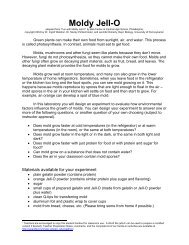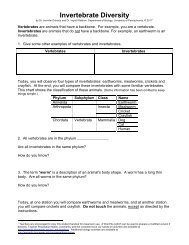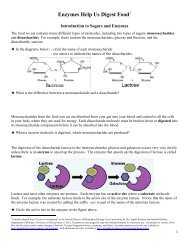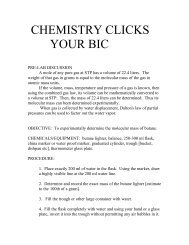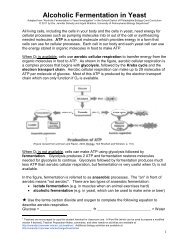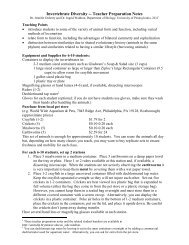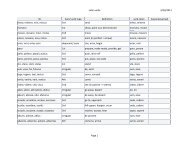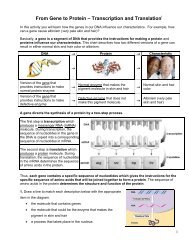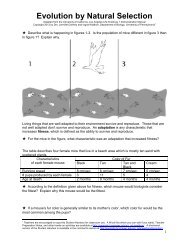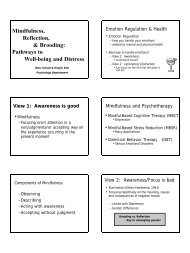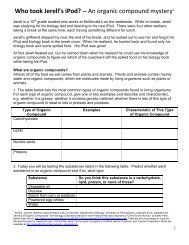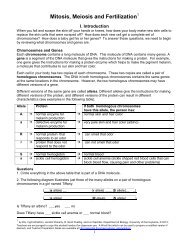From Gene to Protein -- Transcription and Translation ... - Serendip
From Gene to Protein -- Transcription and Translation ... - Serendip
From Gene to Protein -- Transcription and Translation ... - Serendip
You also want an ePaper? Increase the reach of your titles
YUMPU automatically turns print PDFs into web optimized ePapers that Google loves.
in which you provide your preferred definitions for these terms).<br />
To ensure that students develop a good underst<strong>and</strong>ing of the basic processes of transcription <strong>and</strong><br />
translation, this activity omits many complexities (e.g. proteins may have more than one polypeptide;<br />
introns, exons <strong>and</strong> splicing). If your students already have a good grasp of the basic processes, you<br />
may want <strong>to</strong> include some of these points. For example, if you want <strong>to</strong> emphasize learning how <strong>to</strong> use<br />
the st<strong>and</strong>ard chart of codons in mRNA <strong>and</strong> corresponding amino acids, you can replace the chart on the<br />
<strong>to</strong>p of page 5 of the Student H<strong>and</strong>out with the codon chart from your textbook or from the activity<br />
described at the end of this paragraph. This would also provide the opportunity <strong>to</strong> discuss the function<br />
of the start <strong>and</strong> s<strong>to</strong>p codons in initiating <strong>and</strong> terminating translation. Our preference is <strong>to</strong> use the<br />
simplified chart on page 5 of the Student H<strong>and</strong>out, so students can concentrate on underst<strong>and</strong>ing the<br />
process of translation, <strong>and</strong> then later practice using the st<strong>and</strong>ard codon chart in a separate activity such<br />
as "<strong>From</strong> <strong>Gene</strong> <strong>to</strong> Polypeptide – The Roles of the Base-Pairing Rules <strong>and</strong> the <strong>Gene</strong>tic Code"<br />
(http://serendip.brynmawr.edu/exchange/bioactivities/basepair); this discussion/worksheet activity<br />
reviews the information flow from a gene <strong>to</strong> a polypeptide, with an emphasis on underst<strong>and</strong>ing the<br />
roles of the base-pairing rules <strong>and</strong> the genetic code chart.<br />
Background Biology <strong>and</strong> Suggestions for Discussion<br />
The basic points <strong>and</strong> information <strong>to</strong> be included in discussing the questions in the Student H<strong>and</strong>out are<br />
provided in the answer key, available upon request <strong>to</strong> iwaldron@sas.upenn.edu. Additional relevant<br />
background information is provided in the following sections, primarily <strong>to</strong> give you information that<br />
may be helpful for responding <strong>to</strong> student questions.<br />
The type of albinism discussed in the introduction <strong>to</strong> this activity is called oculocutaneous albinism,<br />
because the melanin deficiency results in vision problems as well as pale skin <strong>and</strong> hair color. This type<br />
of albinism is due <strong>to</strong> a defect in the tyrosinase enzyme which catalyzes the first step in the production<br />
of melanin (http://ghr.nlm.nih.gov/gene/TYR).<br />
<strong>Transcription</strong> <strong>and</strong> <strong>Translation</strong><br />
If your students are somewhat hazy about nucleic acid structure <strong>and</strong> the base-pairing rules you may<br />
want <strong>to</strong> use the figure shown on the next page <strong>to</strong> remind them of key background information for<br />
underst<strong>and</strong>ing the discussion of the base-pairing rules on page 2 of the Student H<strong>and</strong>out.<br />
The DNA str<strong>and</strong> we provide is the template str<strong>and</strong> (i.e. the DNA str<strong>and</strong> that is transcribed) for the beta<br />
globin polypeptide of the hemoglobin protein. The other str<strong>and</strong> of the DNA double helix is called the<br />
non-template or sense str<strong>and</strong>; it has the same nucleotide sequence as the RNA produced by<br />
transcription (except of course T in DNA is replaced by U in RNA). If your students ask how the<br />
RNA polymerase is directed <strong>to</strong> transcribe the right str<strong>and</strong> of the DNA double helix, you can explain the<br />
role of the promoter in initiating transcription. This would also provide the opportunity <strong>to</strong> mention that<br />
the rate of transcription of specific genes varies in different types of cells, corresponding <strong>to</strong> the<br />
differences in specific types of proteins in different types of cells (e.g. hemoglobin abundant in red<br />
blood cells <strong>and</strong> the enzyme for making melanin abundant in melanocytes in the skin).<br />
5



